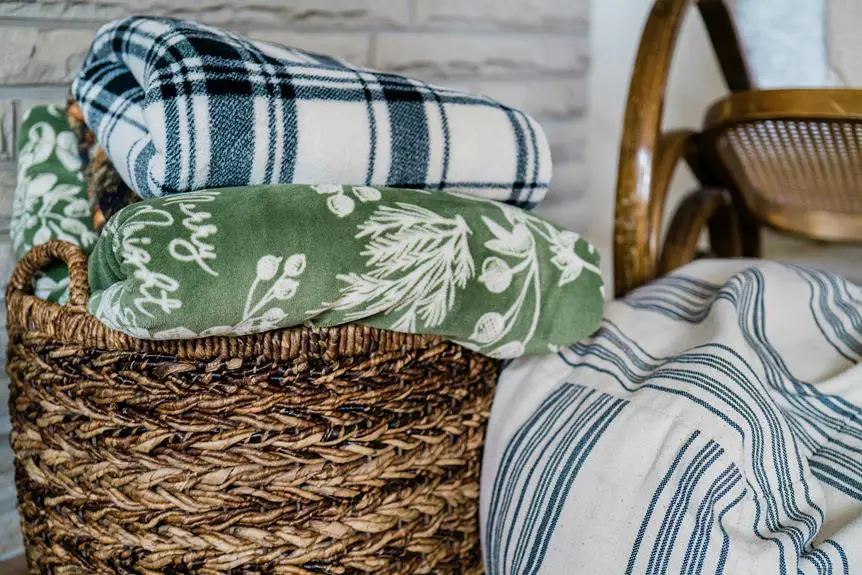When you think about comfort and warmth, fleece and cotton each have their distinct advantages. Fleece shines in retaining heat and keeping you dry during those chilly outdoor adventures, while cotton offers a soft, breathable feel that's hard to beat in milder weather. But have you considered how the choice between these fabrics can impact your overall experience in different environments? Understanding their unique properties can guide you in making an informed decision that suits your needs. Let's explore what might work best for you in various situations.
Table of Contents
Key Takeaways
- Fleece excels in warmth retention and moisture-wicking, making it ideal for cold weather activities and outdoor adventures.
- Cotton offers breathability and softness, making it better suited for warm weather and casual wear.
- Fleece provides insulation and dries quickly, maintaining warmth even in damp conditions, unlike cotton which loses warmth when wet.
- For layering, fleece is preferable in cold temperatures, while cotton is great for a breathable base layer in warmer climates.
Overview of Fleece
Fleece is a lightweight, synthetic fabric that traps warmth while remaining breathable, making it a popular choice for outdoor enthusiasts. When you wear fleece, you'll notice how it keeps you cozy without overheating, which is essential for activities like hiking or skiing. Its soft texture feels great against your skin, so you can wear it for hours without discomfort.
One of the standout features of fleece is its moisture-wicking ability. It efficiently pulls sweat away from your body, helping you stay dry during intense workouts. Additionally, fleece is quick-drying, meaning you won't be stuck in wet clothing if you encounter unexpected rain or snow.
Fleece is also relatively low-maintenance; you can toss it in the washing machine without worrying about shrinkage. Just make sure to avoid fabric softeners, as they can reduce its breathability.
When it comes to versatility, fleece comes in various weights and styles, from lightweight fleeces for layering to thicker options for colder climates. You can easily find fleece jackets, pants, and blankets, making it a staple in your outdoor wardrobe.
Overview of Cotton
Cotton is a natural fiber known for its softness and breathability, making it a popular choice for everyday clothing and casual wear. Its versatility and comfort keep you reaching for cotton garments time and time again.
Whether you're lounging at home or heading out, cotton can adapt to your lifestyle seamlessly.
Here are some key characteristics of cotton:
- Softness: Cotton feels gentle against your skin, reducing irritation.
- Breathability: It allows air to circulate, keeping you cool in warm weather.
- Durability: Cotton fabrics hold up well over time, resisting wear and tear.
- Moisture Absorption: Cotton can absorb moisture, making it ideal for sweat-prone activities.
These qualities make cotton a go-to fabric for various clothing items, from t-shirts to jeans.
You'll find it in everything from bed linens to towels, showcasing its adaptability.
Understanding these attributes can help you appreciate why cotton remains a staple in wardrobes and households alike.
Comfort Comparison
How do fleece and cotton stack up when it comes to comfort in different settings? Each fabric has its unique feel and benefits that cater to your specific needs. Fleece is soft and cozy, making it perfect for chilly evenings or lounging around the house. On the other hand, cotton is breathable and gentle on the skin, ideal for warmer days or active wear.
Here's a quick comparison to help you decide which fabric suits you best:
| Setting | Fleece Comfort | Cotton Comfort |
|---|---|---|
| Indoor Relaxation | Feels warm and snuggly | Light and airy |
| Outdoor Activity | Retains warmth but can be bulky | Moves with you and stays cool |
| Sleepwear | Soft and plush, great for cold | Breathable, prevents overheating |
When you think about comfort, consider the environment and your activities. Fleece wraps you in warmth, perfect for lazy days, while cotton allows your skin to breathe, making it a go-to for physical activities. Your choice truly depends on how you want to feel in the moment.
Warmth Comparison
When considering warmth, you'll find that fleece provides superior insulation, making it ideal for cold weather. Its unique structure traps heat effectively, allowing you to stay cozy even in frigid conditions.
Cotton, on the other hand, tends to absorb moisture, which can leave you feeling chilly and damp.
Here are some key points to remember when comparing warmth between fleece and cotton:
- Heat Retention: Fleece retains body heat well, making it a great choice for chilly environments.
- Moisture Wicking: Fleece dries quickly and wicks moisture away, while cotton tends to hold onto it.
- Breathability: Cotton is more breathable but can let cold air in, which isn't ideal for extreme temperatures.
- Layering: Fleece layers easily over other clothing, enhancing warmth without bulk.
Best Uses for Each Fabric
When choosing between fleece and cotton, think about the weather and your activities.
Fleece shines in cold conditions and is perfect for outdoor adventures, while cotton offers comfort in warmer temperatures and is great for casual wear.
Understanding these factors can help you make the best choice for layering and versatility.
Ideal Weather Conditions
Fleece thrives in chilly conditions, offering warmth and comfort, while cotton shines in warm weather, providing breathability and moisture-wicking properties. When considering which fabric to wear, think about the weather before making your choice.
For cooler days, fleece is your go-to option. It traps heat effectively, making it perfect for outdoor activities or lounging at home. On the other hand, cotton is ideal for hot weather, as it allows air circulation and helps keep you dry.
Here are some ideal weather conditions for each fabric:
- Fleece: Perfect for chilly mornings or evenings, camping trips, or winter sports.
- Cotton: Great for hot, sunny days at the beach, casual summer outings, or indoor wear in air-conditioned spaces.
- Fleece: Works well during transitional seasons, like fall, when temperatures fluctuate.
- Cotton: Best for humid conditions, as it absorbs moisture without feeling heavy.
Activity-Specific Recommendations
Choosing the right fabric for your activities can enhance your comfort and performance, so let's explore where fleece and cotton truly excel.
If you're heading outdoors for a hike or a chilly run, fleece is your best bet. Its ability to wick moisture away from your skin and provide warmth without bulk makes it ideal for those high-energy activities. Fleece keeps you cozy while allowing for movement, making it perfect for active pursuits in cooler weather.
On the other hand, if you're planning a laid-back day at home or a casual outing, cotton shines in comfort. Its softness and breathability make it great for lounging or light activities, like running errands or enjoying a picnic. However, it's best to avoid cotton for intense workouts, especially in colder weather, as it retains moisture and can leave you feeling damp and cold.
For outdoor adventures or physical activities, choose fleece for its warmth and moisture-wicking capabilities.
But when you're looking for comfort and ease in casual settings, cotton is the way to go. Knowing these distinctions can help you make smarter choices based on your activities.
Layering and Versatility
Understanding how to layer with fleece and cotton can enhance your comfort and adaptability in varying weather conditions. Each fabric has its strengths, making them suitable for different situations. Here's a quick breakdown of when to use fleece and cotton for layering:
Fleece: Ideal for colder temperatures, fleece traps heat well and is lightweight, making it perfect for outdoor activities like hiking or skiing.
Cotton: Best for warmer climates, cotton breathes easily and absorbs moisture, keeping you comfortable during sunny days or light workouts.
Base Layer: Start with a cotton tee for breathability, then add a fleece layer for warmth when things get chilly.
Outer Layer: If you're facing wind or rain, a fleece jacket can provide insulation while a cotton outer layer can be used for casual outings.
Versatile Pairing: Combine both fabrics by wearing a cotton shirt under a fleece pullover, allowing you to adjust your outfit based on the temperature.
Care and Maintenance Tips
When it comes to caring for fleece and cotton, knowing the right washing and drying tips can make a big difference.
You'll also want to pay attention to how you store each fabric to keep them in top condition.
Let's explore some essential care and maintenance tips for both materials.
Washing and Drying Tips
To keep your fleece and cotton garments in top shape, follow these essential washing and drying tips. Taking proper care of your clothing won't only extend their lifespan but also maintain their comfort and warmth.
- Wash in cold water: Use cold water for both fleece and cotton to prevent shrinking and fading.
- Use mild detergent: Opt for a gentle detergent to avoid harsh chemicals that can damage the fabric fibers.
- Separate colors: Always wash darks and lights separately to prevent color bleeding and keep your whites bright.
- Avoid fabric softeners: These can coat fleece and reduce its breathability, making it less effective at keeping you warm.
Storage Recommendations
Storing your fleece and cotton garments properly ensures they remain in excellent condition and ready for use.
For fleece, it's best to hang or fold them in a cool, dry place. Avoid using hangers with clips, as they can cause creases. If you choose to fold, stack them neatly to prevent stretching. Make sure they're completely dry before putting them away to avoid mildew.
For cotton garments, you can either hang or fold, but ensure they're clean and dry first. Cotton is prone to wrinkles, so if you're folding, do so carefully to minimize creasing. Use breathable storage bags or bins to protect against dust. Avoid plastic bags, as they can trap moisture and lead to mildew.
Always store these items away from direct sunlight to prevent fading. If you have seasonal clothing, consider vacuum-sealing them to save space and protect them from pests.
Regularly check your stored garments for any signs of damage or odor, and be proactive in addressing any issues. By following these simple storage tips, you'll keep your fleece and cotton looking great for many wears to come!
Frequently Asked Questions
Can Fleece or Cotton Be Recycled Effectively?
Yes, fleece and cotton can be recycled, but their processes differ. You'll find that cotton is generally easier to recycle due to its natural fibers, while fleece, often made from polyester, requires specialized facilities.
What Are the Environmental Impacts of Fleece Versus Cotton?
You'll find that fleece production often involves synthetic materials, leading to microplastic pollution, while cotton farming uses significant water and pesticides. Both have environmental impacts, so consider choosing sustainable options to minimize your footprint.
Are There Hypoallergenic Options for Fleece or Cotton?
Yes, there are hypoallergenic options for both fleece and cotton. You can find fleece made from synthetic materials labeled as hypoallergenic, while organic cotton is often treated without harsh chemicals, making it gentler on sensitive skin.
How Do Fleece and Cotton Compare in Terms of Durability?
When comparing durability, fleece often outlasts cotton due to its synthetic fibers, which resist wear and tear. However, high-quality cotton can also be durable, especially when properly cared for. Your choice depends on intended use.
Which Fabric Is Better for Sensitive Skin?
When it comes to sensitive skin, you'll find that natural fibers like cotton are generally gentler. Fleece can sometimes irritate due to synthetic materials, so choose cotton for comfort and reduced risk of irritation.
- How Does Ring Spun Cotton Affect Garment Fit and Shape Retention? - August 13, 2024
- What Are the Challenges in Producing Ring Spun Cotton? - August 13, 2024
- Is Ring Spun Cotton Suitable for Plus-Size Clothing? - August 13, 2024







